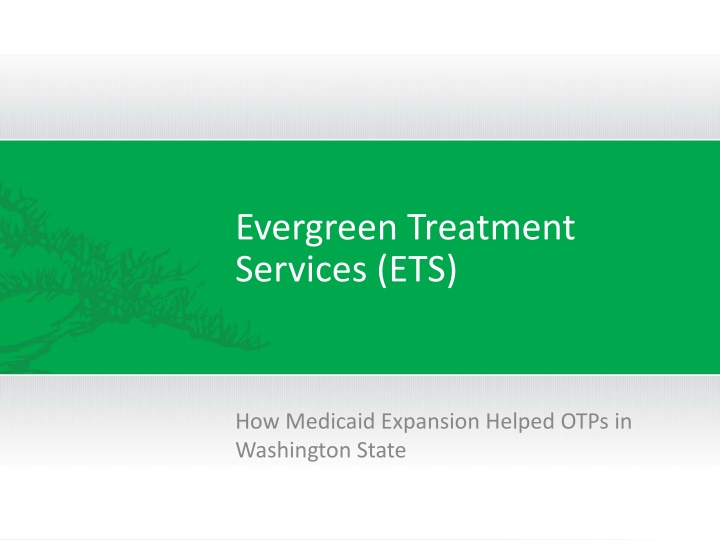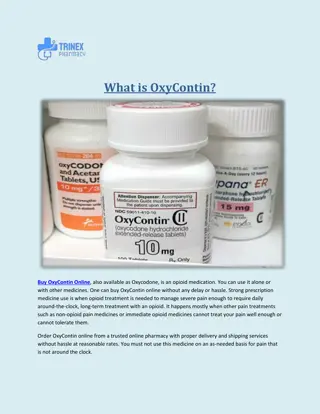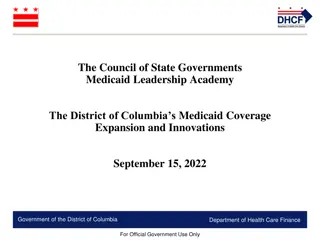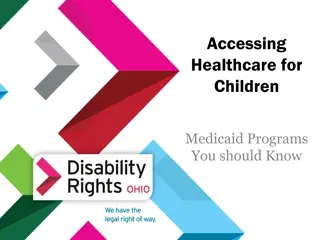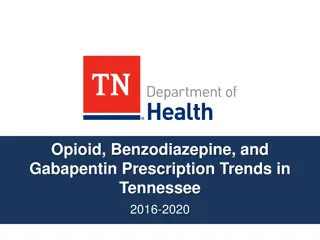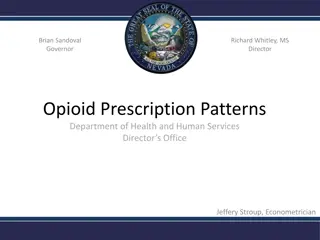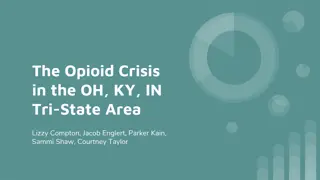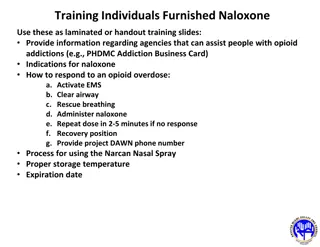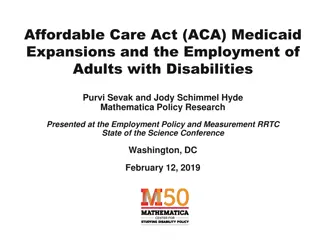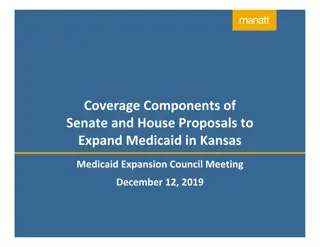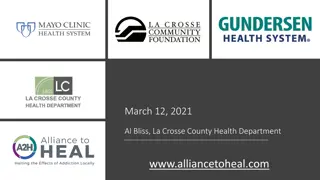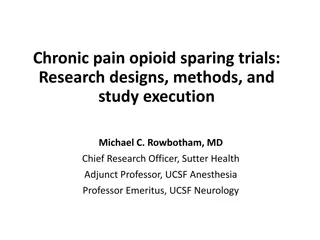Medicaid Expansion Impact on Opioid Treatment Programs in Washington State
Evergreen Treatment Services (ETS) in Washington State benefitted from Medicaid expansion, which provided coverage for opioid treatment services. The expansion increased treatment slots, reduced waitlists, and improved access to medication-assisted treatment for thousands in need. Medicaid funding facilitated collaboration between state and local officials to meet the clinical demand, ultimately reducing societal costs related to opioid addiction.
Download Presentation

Please find below an Image/Link to download the presentation.
The content on the website is provided AS IS for your information and personal use only. It may not be sold, licensed, or shared on other websites without obtaining consent from the author.If you encounter any issues during the download, it is possible that the publisher has removed the file from their server.
You are allowed to download the files provided on this website for personal or commercial use, subject to the condition that they are used lawfully. All files are the property of their respective owners.
The content on the website is provided AS IS for your information and personal use only. It may not be sold, licensed, or shared on other websites without obtaining consent from the author.
E N D
Presentation Transcript
Evergreen Treatment Services (ETS) How Medicaid Expansion Helped OTPs in Washington State
Evergreen Treatment Services who we are 1 ETS is a private, nonprofit that provides medication assisted treatment for adults with opioid use disorders Serving more than 2,500 adults 4 locations in western Washington state Dispense methadone and buprenorphine Have started a Suboxone prescribing program Beginning to offer integrated mental health and primary care services 10/3/2024
Scope of Opioid Epidemic in Washington State
Drug Overdoses Have Been Climbing 3 10/3/2024
Death Rates Due to Opioids 4 10/3/2024
Medicaid Expansion and OTPs in Washington State
Context 6 ACA enacted March 2010 Washington was one of five states that utilized a provision in the ACA that allowed for early expansion of Medicaid, prior to 2014. As of 2011, Washington was using a waiver from CMS to allow for federal funding to cover adults with incomes up to 133 percent of poverty. 10/3/2024
Medicaid Expansion in Washington 7 As of 2015, >525,000 gained Medicaid or CHIP coverage. Treatment for substance use disorders, including Opioid Treatment Program services became an essential benefit. Provided access to MAT for an estimated 40,000 in need in 2010 ACA provided needed funding for OTP services 10/3/2024
How Did Added Medicaid Coverage Help? 8 Increased coverage meant more treatment slots Demand was suppressed when treatment was unavailable Wait lists exceeded one year Potential patients gave up trying to get in Patients travelled hours per day to receive daily medication Many paid out of pocket when they couldn t afford to Initiated collaboration between state & local officials How to meet the clinical need? Meeting the demand will reduce societal costs 10/3/2024
Discussions at State Level Expand Treatment? 9 DSHS Division of Behavioral Health and Recovery State Opioid Treatment Authority 10/3/2024
Washington State Medicaid Expansion: DBHR 10 DSHS Division of Behavioral Health and Recovery: Houses the State Opioid Treatment Authority (SOTA) Is our accreditation body Has conducted multiple cost-benefit and cost-effectiveness studies on SUD 2004 state analysis of Medicaid payment for OTP services vs those untreated: Cost offset of $765 pp/per month 80% in medical costs >1 year of treatment = greatest cost offset Longer stays = reduced criminal re-arrest and conviction Reference: https://www.dshs.wa.gov/sites/default/files/SESA/rda/documents/research-4-49.pdf 10/3/2024
How DBHR Helped OTPs with Medicaid Expansion 11 DBHR began supporting county requests for OTPs Find ways to reallocate funds to support OTPs Transportation dollars Medicaid transport reallocated to treatment delivery Supported 2 bundled rate increases in 2015 Badly needed infrastructure investments Capital, administrative Salary improvements Many staff had not seen salary increase in more than 4 years We were losing good staff 10/3/2024
Example: ETS Grays Harbor Clinic - 2014 12 10/3/2024
Example: ETS Grays Harbor Clinic 13 Hoquiam, Washington Rural (pop 71,000, 2200 sq miles,) Declining timber, fishing industries 8.8% unemployment Some of state s worst health indicators One of highest opioid overdose death rates in state Syringe exchange utilization: # needles exchanged is on par with King County (Seattle) Only treatment = local hospital which restricted Medicaid admissions due to low reimbursement 10/3/2024
Example: ETS Grays Harbor Clinic 14 Currently serving n=350 patients Reduced annual Medicaid transportation costs by several millions of dollars More $ was spent on transporting 50 patients to out-of- county OTPs than on the entire clinic s needed treatment budget. Reduced crime Employment, family health, primary care improvements 10/3/2024
DBHR: More OTPs Open 15 Between 2013 and 2016, 3 more OTPs opened in the state Includes 2 by ETS In 2015, state legislature and DBHR approved 2 Medicaid bundled rate increases for OTPs totaling $2.16 pp/day. Long overdue salary increases Infrastructure investment: administrative and physical plant 10/3/2024
DBHR: Expanding Access to Care 16 All counties with ETS clinics raised patient census cap ETS patient census increased by n=1000 Expanded dispensary hours Specialized programming for targeted patient groups: Needing more intensive programming to stabilize Accommodating a broader range of work hours Specialized buprenorphine dispensing hours 10/3/2024
State Medicaid Expansion: Health Care Authority 17 State Health Care Authority: 2013: new Chief Medical Officer and Deputy Chief Medical Officer Suboxone prescriber Understands cost-effectiveness of expanded treatment Lifted lifetime Medicaid restriction on bup prescriptions Clarified state rules so OTPs can dispense bup Required MCOs to contract with OTPs on dispensed bup Facilitated OTPs dispending naloxone kits 10/3/2024
Combined DBHR and HCA Partnership Strength 18 Providing OTP guidance and support on: 3rd party insurance contracting OTPs becoming Medical Homes OTPs developing Office Based Opioid Treatment programs (prescriptions for Suboxone) Use of telehealth 9 WA OTPs with SAMHSA exceptions for ARNPs and PA-Cs to write medical orders Helped to control costs 10/3/2024
Result of all this from a business perspective? 19 Patients are better served ETS is a much stronger business Revenue streams have diversified Infrastructure has been strengthened Salaries are in line with other nonprofits Future options available to ETS: More contracts with 3rd party insurance Bup dispensing as a separate program Medical Home More infrastructure (capital assets, administrative) Continued diversification of programs 10/3/2024
Alignment of Federal, State, Local Priorities 20 Medicaid Expansion has helped OTPs to meaningfully contribute to addressing opioid epidemic More points of service More patients being served Expand clinical programs for targeted populations Has fostered key partnerships for system improvement HCA and DBHR alignment has strengthened OTPs Has helped Washington state engage in interdisciplinary discussions about community solutions 10/3/2024
Secondary Gains from Alignment 21 State Opioid Task Force Prevention, medical disposal, prescribing practices King County (Seattle): Funding/loan assistance to open new OTP County/city heroin task force Eliminate OTP census cap Provide low barrier bup prescriptions Encourage MDs to become waivered and prescribe bup Rural Counties: Obtaining service providers where none existed (esp. using telehealth) 10/3/2024
Medicaid Expansion Has Helped Washington State Respond to the Opioid Epidemic
